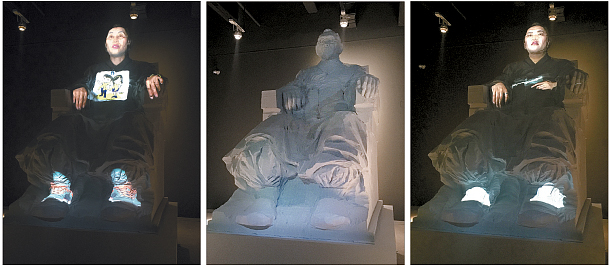Artist gives Korean dreams a contemporary twist : Hero’s monument becomes a backdrop for stories told by society’s disenfranchised

The image of a 2014 Sewol ferry victim’s mother, left, and that of a young female laborer, right, projected onto the reproduction of the statue of Kim Koo, center, a respected politician in Korea. It is part of the exhibition “Krzysztof Wodiczko: Instruments, Monuments, Projections” at MMCA Seoul. [MOON SO-YOUNG]
They include a mother who lost her son in the 2014 Sewol ferry sinking, a laborer who was laid off due to his company’s restructuring, a North Korean artist who defected to the South and a gay rights activist. They also share their wishes for a better society, which makes sense given that the media installation by the renowned Polish artist Krzysztof Wodiczko,74, is called “My Wish.” It is based on Kim Koo’s 1947 essay of the same title.
This is part of Wodiczko’s first retrospective in Korea. He is internationally acclaimed for public art projects that reverse the intended messages of monuments in big cities around the world. Grand monuments and splendid building facades are meant to show off a city’s power and glory, but Wodiczko has turned them into film screens on which the cities’ neglected people or social minorities appear and speak out. As they are projections on major monuments, even passers-by who never took interest before pay attention to the voices.
Over the past three decades, he has had interviews with immigrant workers, survivors of domestic violence, traumatized war veterans and survivors of the bombing of Hiroshima. He has projected their images and voices at sites around the world. Video records of ten of the artist’s public art projects are now on display at the MMCA Seoul exhibition titled “Krzysztof Wodiczko: Instruments, Monuments, Projections.”
“My Wish” is the artist’s latest work for this retrospective. For it he read a translation of Kim’s essay and held interviews with dozens of people in Korean society.

Left: Artist Krzysztof Wodiczko explains his work at a press meeting at the National Museum of Modern and Contemporary Art (MMCA)’s Seoul branch last week. Middle: The facade of the City Hall in the Belgian city of Mechelen shows the video projections of the eyes of immigrant newcomers in the city as part of Wodiczko’s work “NEWTOPIA.” in 2012. Right: the artist’s “Homeless Vehicle”(1988) is on view at the MMCA’s Seoul branch, through Oct. 9. [YONHAP, MMCA, MOON SO-YOUNG]
Wodiczko also pointed out that Kim wanted Korea to be the world’s most “beautiful country,” rich in culture but with only enough power and wealth to sustain its independence and happiness. “It was a utopian dream…. Utopia is the horizon that might never be reached but we should try,” the artist said.
Among the exhibits are also objects and instruments developed by the artist, who started his career as an industrial designer. They are on display with photographs of how they are used. Many of the instruments are for underprivileged people such as “Homeless Vehicle,” which the homeless can use as a portable dining table and bed. There is also an instrument “Porte-Parole” to promote free speech.
“The act of speaking has been fundamental to Wodiczco’s works from the very beginning, representing a basic right that must be fairly granted to every member of society,” the MMCA said in a statement.
BY MOON SO-YOUNG [symoon@joongang.co.kr]
The exhibition runs through Oct. 9. Admission is 4,000 won ($3.49.) Go to Anguk subway station, line No.3, exit No.1 and walk 10 minutes. For details, visit www.mmca.go.kr or visit (02) 3701-9600.










with the Korea JoongAng Daily
To write comments, please log in to one of the accounts.
Standards Board Policy (0/250자)